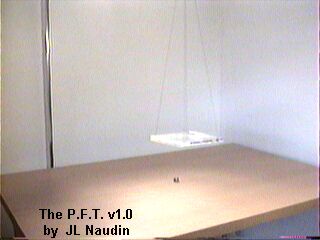
The Poynting Flow Thruster v1.0
Further with the ARDA Project...
By Jean-Louis Naudin
created on August 15th, 1999 - JLN Labs - Last update December 11th, 2001

The Poynting Flow Thruster
v1.0
Further with the ARDA
Project...
By Jean-Louis Naudin
created on August 15th, 1999 - JLN
Labs - Last update December 11th, 2001
This project is the logical continuation of the ARDA Project based on the Biefeld-Brown effect. The purpose of this experiment is to demonstrate that it is possible to generate an unidirectional thrust by using an asymmetrical flow of the Poynting energy in a capacitor.
During a charging process of a flat capacitor, the Poynting vector ( S=ExH ) comes from outside the capacitor towards the wire connections, parallel to the surface of the armatures inside the dielectric medium. There is an energy flow directly proportional to ExB. This energy is not provided by the wires but comes from the surrounding space around the capacitor. ( ref: "The Feynman Lectures on Physics : Electromagnetism vol2, Chap: 27-5, fig 27-3" by Addison-Wesley Publishing company. )

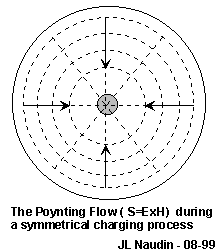
During the charging process, in a flat
capacitor with the wires connected in the middle of the
armatures,
the energy flow (S-Flow) is symmetrical. (see the picture above)
During the charging process, in a flat
capacitor with the wires connected near the edge of the
armatures,
the energy flow (S-Flow) is asymmetrical. (see the picture below
)
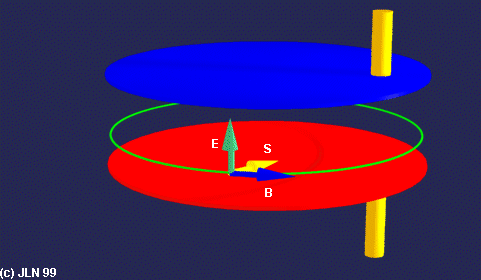
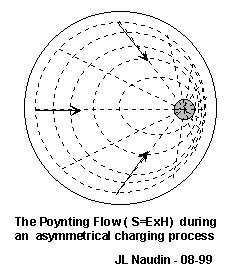
The main idea is to check if an asymmetrical energy flow during the charging process of a flat capacitor is able to generate a thrust.
Experimental setup: The flat capacitor has been built with a common CD-ROM plastic box ( 125 x142 x 10 mm )made with plexiglas (as dielectric ( thickness = 1mm ). The outside and the inside have been covered by an aluminum sheet (120 x 110 mm) . The apparatus has been tethered with nylon wire on a specialy balanced equipement. The edges of each armature have been covered by an adhesive tape for reducing the leakage current and some eventual striking. The 30kV DC High Voltage generator has been placed under a wooden table just under the rotation axis. Two thin copper wires have been connected at 10 mm distance from the edge of each armature ( one has been connected to the zero potential and the other to the 30kV DC High Voltage generator ). The capacitance of this capacitor is 15pF ( measured with a digital capacimeter ), at full charge, this gives an electrostatic energy of 7 mJ .

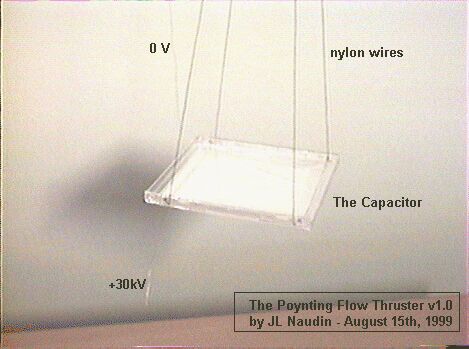
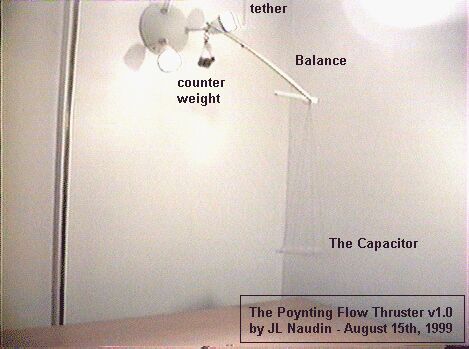
Tests Results : When the +30kV DC High Voltage generator is switched on, the PFT v1.0 begins to set in motion and continues to turn continuously ( see below, the video of the demonstration ). Its seems now possible to generate an unidirectional thrust by using an unbalanced flow of energy induced by an asymmetrical Poynting flow during the charging process in a flat capacitor. The resulting thrust shows that this principle can be used as a thruster in the vaccum space, this may open a new way in space propulsion...

RealVideo of the PFT v1.0 demonstration (165kb)
RealVideo of the PFT v1.0 demonstration, close view (81kb)
( if you don't have the RealPlayer 5.0, you may download it freely at : http://www.real.com/products/player/ )
| TITLE
: Poynting
Vector Probe for Measuring Electrical Power http://patents1.ic.gc.ca/details?patent_number=1264183&language=EN_CA (12) Patent: (11)
CA 1264183
|
See also :
The PFT v2.0, a spaceship mock-up, towards the deep space.....
![]() Email : JNaudin509@aol.com
Email : JNaudin509@aol.com
Return to the Advanced Propulsions Researches page